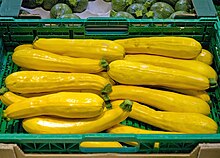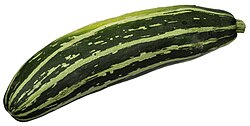**Zucchini Naming and Etymology:**
– Zucchini, courgette, and baby marrow are common names for the plant.
– The origins of zucchini trace back to 19th-century northern Italy.
– The plant is closely related to marrow, with fruits harvested at a specific stage.
– Zucchinis come in various colors and are typically harvested at a specific size.
– Different regions use varying terms like zucchini, courgette, and baby marrow.
**Culinary Uses and Nutrition:**
– Zucchini is used in various culinary dishes like ratatouille and frittatas.
– The vegetable can be cooked in multiple ways such as steamed, grilled, or baked.
– Zucchini is low in calories and rich in nutrients like vitamins and minerals.
– It can be incorporated into bread, cake, or used as a pasta substitute.
– Zucchini is a versatile ingredient with multiple health benefits.
**Toxicology and Safety Concerns:**
– Zucchini, part of the Cucurbitaceae family, can contain toxins like cucurbitacins.
– Cultivated zucchinis generally have low toxin levels, but caution is needed.
– Zucchini can cause allergies due to the presence of certain proteins.
– Handling young zucchinis can lead to skin reactions due to sap.
– Proper cultivation practices can minimize risks associated with zucchini consumption.
**Cultivation and Cultivars:**
– Zucchini is easy to grow in temperate climates and known for high production.
– The immature fruit, flowers, mature fruit, and leaves of zucchini are edible.
– Bees play a crucial role in pollination for successful fruit development.
– Various zucchini cultivars exist, like Bianco di Trieste and Black Beauty.
– Different varieties and mutations of zucchinis offer diverse options for cultivation.
**Miscellaneous Information:**
– Zucchini is also known as courgette in some regions.
– Zucchini plants grow as bushes and have versatile culinary uses.
– Zucchini is a nutritious and low-calorie vegetable suitable for various dishes.
– Allergies and safety concerns related to zucchini consumption are documented.
– Proper handling and cultivation practices can ensure safe and enjoyable zucchini consumption.
The zucchini (/zuˈkiːni/ ⓘ; pl.: zucchini or zucchinis), courgette (/kʊərˈʒɛt/) or baby marrow (Cucurbita pepo) is a summer squash, a vining herbaceous plant whose fruit are harvested when their immature seeds and epicarp (rind) are still soft and edible. It is closely related, but not identical, to the marrow; its fruit may be called marrow when mature.
| Zucchini | |
|---|---|
Striped and uniform-colored zucchini | |
| Genus | Cucurbita |
| Species | Cucurbita pepo |
| Origin | 19th-century northern Italy |

Ordinary zucchini fruit are any shade of green, though the golden zucchini is a deep yellow or orange. At maturity, they can grow to nearly 1 metre (3 feet) in length, but they are normally harvested at about 15–25 cm (6–10 in).
In botany, the zucchini's fruit is a pepo, a berry (the swollen ovary of the zucchini flower) with a hardened epicarp. In cookery, it is treated as a vegetable, usually cooked and eaten as an accompaniment or savory dish, though occasionally used in sweeter cooking.
Zucchini occasionally contain toxic cucurbitacins, making them extremely bitter, and causing severe gastero-enteric upsets. Causes include stressed growing conditions, and cross pollination with ornamental squashes.
Zucchini descends from squashes first domesticated in Mesoamerica over 7,000 years ago, but the zucchini itself was bred in Milan in the late 19th century.


